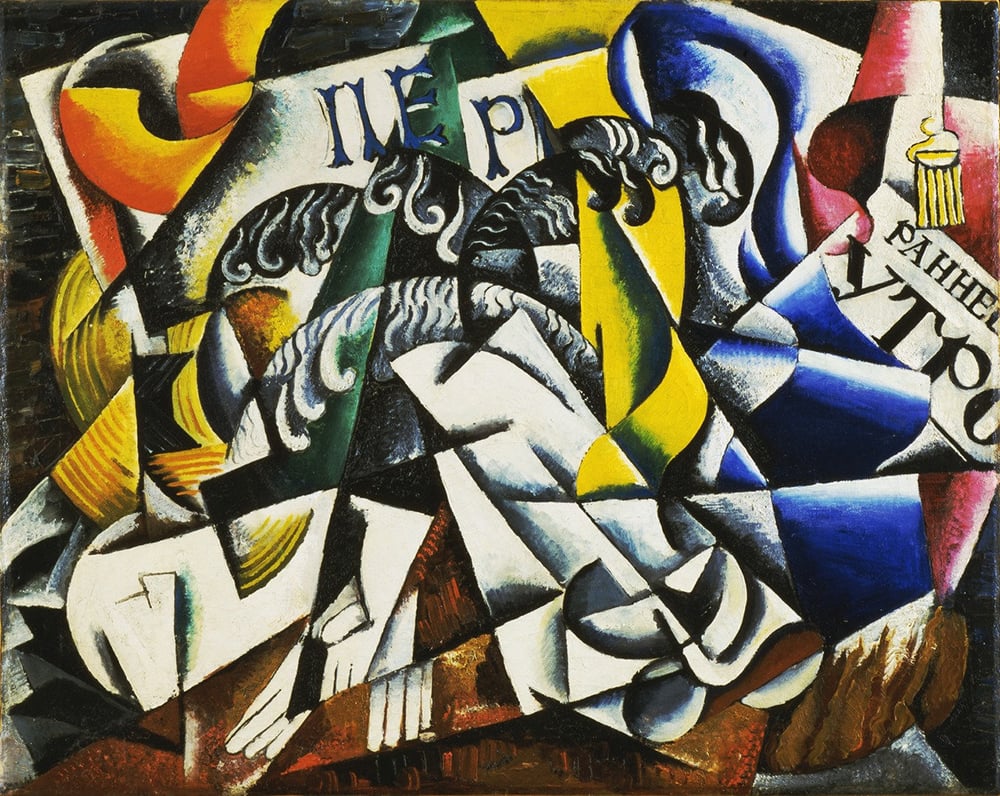
Pioneering Russian artists take the center stage at New York’s Museum of Modern Art for “A Revolutionary Impulse: The Rise of the Russian Avant-Garde,” which opens on December 4. In addition to showcasing the work of well-known male artists such as Alexandr Rodchenko and Kazimir Malevich, the show, which spans the period from the end of World War I to 1932, also shines a spotlight on the women that helped drive the movement.
The Russian Avant-Garde movement can be traced not only through painting but also through the period’s poetry, film, and photomontage. So it comes as no surprise that the women included in “A Revolutionary Impulse” worked across fields, demonstrating their creativity in countless forms.
In anticipation of the exhibition, here’s four female Russian artists to see up close this December.
Olga Rozanova, The Factory and the Bridge (1913). Courtesy of the Museum of Modern Art, New York, the Riklis Collection of McCrory Corporation.
1. Olga Rozanova (1886–1918)
Even without a formal arts education, Olga Rozanova made a name for herself as a major innovator of the Russian avant-garde with her Italian Futurist-influenced painting, which incorporated elements of poetry.
Her abstract work was part of Malevich’s Suprematist movement, but with a more decorative touch. Shortly before her death, Rozanova created a series of “color painting” works that are now seen as a pre-cursor to the Abstract Expressionist movement developed by American artists over 30 years later.
Lyubov Popova, Untitled (circa 1916–17). Courtesy of the Museum of Modern Art, New York, the Riklis Collection of McCrory Corporation.
2. Lyubov Popova (1889–1924)
Lyubov Popova’s career was short but memorable, securing herself a place in the Russian art historical canon with her artistic innovations, which blended Cubism and Futurism. Widely travelled, Popova made work with a broad range of international influences. In addition to painting, she also designed textiles, typography faces, and Bolshevik pamphlets, later abandoning the canvas as part of the Constructivist movement.
Her work hung alongside that of Malevich, in “Tramway V: The First Futurist Exhibition,” held in St. Petersburg in 1915, and Moscow’s Stroganov Institute in 1924 held a posthumous retrospective of her work.
Natalia Goncharova, Christian Host from Mystical Images of War (1914). Courtesy of the Museum of Modern Art, New York, gift of the Judith Rothschild Foundation. © 2016 Artists Rights Society (ARS), New York/ADAGP, Paris
3. Natalia Goncharova (1881–1962)
A painter, writer, costume designer, and set designer, Natalia Goncharova studied at the Moscow Institute of Painting, Sculpture, and Architecture before dropping out to help form the group Jack of Diamonds.
Inspired by Russian icons and folk art, Goncharova blended the Russian Primivist movement with Fauvism and Cubo-Futurist art. She was a divisive figure, choosing to wear men’s attire and to live with her life partner, Mikhail Larionov, for decades before marrying him.
Alexandra Exter, Construction (1922–23). Courtesy of the Museum of Modern Art, New York, the Riklis Collection of McCrory Corporation.
4. Alexandra Exter (1882–1949)
After exploring Cubism in Paris in 1910, Alexandra Exter, a friend of Pablo Picasso and Georges Braque, returned to her native Russia, where she was a leading light of the new Constructivist movement.
Straddling Suprematism and Curbo-Futurism, the experimental artist was known for her stage and costume design. She also influenced the Art Deco movement.
“A Revolutionary Impulse: The Rise of the Russian Avant-Garde,” is on view at the Museum of Modern Art, 11 West 53rd Street, from December 4, 2016–March 12, 2017.